Click On Image
For Full Size | Size |
Image Description |
Source
By |
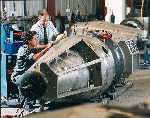 | 68k | Main Assembly Workshop - Cowan Transportable Recompression Chamber Systems during manufacture. | Courtesy of cowanmfg.com.au. |
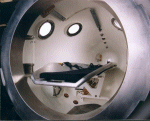 | 42k | Interior view of Cowan Transportable Recompression Chamber - male NATO connection flange in foreground. | Courtesy of cowanmfg.com.au. |
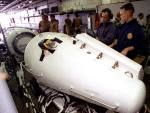 | 328k | Navy Diving Community Supports Miners'Rescue.
By Chief Journalist David Nagle, Naval Sea Systems Command Public Affairs
SOMERSET, Pa. (NNS) -- The recent rescue of nine trapped coal miners in Somerset, Pa., involved the combined efforts of several local, state and federal agencies.
This team included members of the Navy’s diving and salvage community, including divers from Naval Sea Systems Command’s Supervisor of Salvage and Diving (SUPSALV) directorate and Explosive Ordnance Disposal (EOD) Technical Division in Indian Head, Md.
When the Navy learned of the mine collapse, the Chief of Naval Operations'Office directed SUPSALV to support the rescue operations by providing assistance and equipment to treat the miners for possible decompression problems. SUPSALV quickly assembled a team of diving and medical experts from the Fleet – from commands including Underwater Construction Team One, Mobile Diving and Salvage Unit Two, EOD Mobile Unit Two, SEAL Delivery Vehicle Team Two, EOD Technical Division (EODTECHDIV) and the Bureau of Medicine.
Within hours, the SUPSALV and EODTECHDIV personnel were on scene, with the rest of the team on their way to Somerset to assist.
SUPSALV learned that the miners were trapped in an area of the mine containing an air pocket. As the water level increased in the mine, it caused the pressure in the air pocket to increase, creating an environment of pressure equivalent to being in about 40 feet of water.
“Assuming the miners remained in that pressure environment, they would have needed about 25 hours to decompress in the mine, or about five hours if they were transferred to a recompression chamber and given oxygen to speed decompression,” said Medical Corps Capt. Henry Schwartz, SUPSALV’s Diving Medical Officer and the senior Navy representative at the rescue site.
The Navy diving team arrived with decompression chambers and the new Emergency Evacuation Hyperbaric Stretchers (EEHS), foldable Kevlar tubes just now being delivered to the Fleet. The SUPSALV personnel brought one of the EEHS units with them, carrying it in the back of a rented vehicle.
Within 18 hours of receiving the first phone call, the diving team was set up and ready to treat miners.
Meanwhile, the rescue team pumped water from the mine, lowering the pressure in the area where the miners were trapped. This action slowly decompressed the space and the miners, to the point where the pressure was normal by the time the miners were rescued.
Schwartz and a hospital corpsman from EODTECHDIV treated one of the miners with symptoms of decompression illness, using a Transportable Recompression Chamber System, with good results.
Throughout the rescue operation, there was a general feeling of optimism by both the rescuers and the family members of the trapped miners.
“It was extremely gratifying to see all the various people and groups pulling together,” Schwartz said. “Little has been said about the drillers, but they worked around the clock with little rest for three days.”
This operation provided the added benefit of training for the diving community, said Schwartz.
“It gave us the chance to rapidly mobilize units for a scenario that could be very similar to a disabled submarine with men trapped under increased pressure at the bottom,” he said.
The overall operation and the Navy’s participation ran “textbook smooth,” according to Schwartz, due in large part to the professionalism and dedication of the Navy diving community.
“Our preparation went rapidly because many of our people accepted responsibility before being officially tasked,” he said. “When the tasking came down, they were ready to go.
“I was proud to represent the Navy, and I’m sure to a person everyone else in our group was as well.”
At sea aboard the amphibious transport dock ship Denver (LPD-9) on 19 June 1997, Machinery Repairman 3rd Class Erin Telitz and Signalman 1st Class Joel Blea attached to Explosive Ordnance Disposal Mobile Unit 3 (EOD Mob. Unit 3) talk with a "patient" inside a transportable recompression chamber system (TRCS) during Exercise Kernel Blitz '97.
These devices are used on divers who are brought to the surface too quickly for the body to properly decompress. The chamber recompresses the diver to a safe depth, and then slowly recompresses to normal pressure. Exercise Kernel Blitz '97 was an exercise near the Southern California coast designed to train U.S. Sailors and Marines and Canadian and Australian troops in amphibious operations. | USN photo # N-3149V-002 by Photographer's Mate 2nd Class Jeff Viano, courtesy of chinfo.navy.mil. |
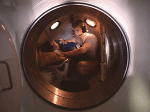 | 88k | At sea aboard the amphibious transport dock ship Denver (LPD-9) 19 June 1997, Hospital Corpsman 3rd Class Larry Eddingfield demonstrates patient care in a Transportable Recompression Chamber System (TRCS) during Exercise Kernel Blitz '97. | USN photo # N-3149V-002 by Photographer's Mate 2nd Class Jeff Viano, courtesy of chinfo.navy.mil. |
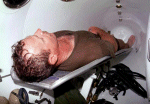 | 47k | A U.S. Navy Sailor demonstrates the available space inside a Transportable Recompression Chamber System (TRCS) at Queensland, Australia, 1 March 1997. These devices are used on divers who are brought to the surface too quickly for the body to properly decompress. The chamber recompresses the diver to a safe depth, and then slowly recompresses to normal pressure. | USN photo # N-7159P-010 by Photographer's Mate 2nd Class Class H. Wolfgang Porter, courtesy of chinfo.navy.mil. |
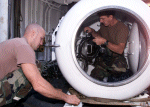 | 217k | Navy divers aboard Grapple (ARS-53) prepare the transportable recompression chamber (TRCS) for service. The (TRCS) will be used aboard Grapple to treat diving emergencies during the recovery wreckage and victimes from the crash of EgyptAir Flight 990. | USN photo # N-9407M-507 by Photographer's Mate 3rd Class Isaac D. Merriman, courtesy of chinfo.navy.mil. |
 | 103k | Lumut, Malaysia 19 July 2001, Lt. Cmdr. Wanzaldi Abdul, from the Royal Malaysian Navy, looks as on Lt. Cmdr. Zaini Awangnik inspects a Transportable Recompression Chamber System (TRCS). Mobile Diving Salvage Unit One (MDSU-ONE) is conducting training with Royal Malaysian Navy divers during the seventh annual Cooperation Afloat Readiness and Training (CARAT) 2001 exercise. CARAT, a series of bilateral exercises, takes place throughout the Western Pacific each summer. It aims to increase regional cooperation and promote interoperability with each participating country. The countries participating in this years CARAT 2001 are Indonesia, Singapore, Philippines, Thailand, Malaysia and Brunei. | USN photo # N-9271Z-003 by Photographer's Mate 2nd Class Erin A. Zocco, courtesy of chinfo.navy.mil. |
 | 55k | U.S. Navy diver BM1(DSW/SW) Rod Smith shows Malaysian divers the U.S. Navy Transportable Recompression Chamber System (TRCS) with a built-in breathing system during CARAT cross-training.
| USN photo # N-9271Z-002 by PH1(AW/SW) Kevin H. Tierney, USN, courtesy of forum.apan-info.net. |
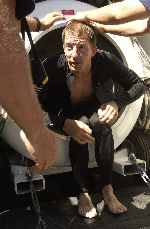 | 170k | Pacific Ocean, 16 July 2004 - Hull Maintenance Technician 2nd Class Justin Culver, a Navy Diver assigned to Mobile Diving Salvage Unit One (MDSU-1), exits the Transportable Recompression Chamber System (TRCS), aboard USNS Sioux (T-ATF 171), after completing his decompression obligation during mixed gas diving salvage operations during exercise Rim of the Pacific (RIMPAC) 2004.
Sioux is one of the seven fleet ocean tugs operated by the Navy's Military Sealift Command. They are part of MSC's Naval Fleet Auxiliary Force operating in direct support of U.S. Navy fleets deployed around the world. RIMPAC is the largest international maritime exercise in the waters around the Hawaiian Islands. This year's exercise includes seven participating nations; Australia, Canada, Chile, Japan, South Korea, the United Kingdom and the United States. RIMPAC is intended to enhance the tactical proficiency of participating units in a wide array of combined operations at sea, while enhancing stability in the Pacific Rim region. | USN photo # N-6811L-291 by Photographer's Mate 1st Class David A. Levy, courtesy of chinfo.navy.mil. |
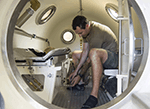 | 988k | Key West, Florida, 20 September 2016: Hospital Corpsman 1st Class John Moore, assigned to Mobile Diving and Salvage Unit (MDSU) 2, Company 2-3, performs maintenance on a transportable recompression chamber during a training evolution aboard MV Brandon Bordelon. The evolution is part of Company 2-3's two-week final certification exercise. MDSU 2, the only east coast mobile diving and salvage unit, is headquartered at Joint Expeditionary Base Little Creek-Fort Story. | U.S. Navy photo # 160920-N-SF508-065 by Mass Communication Specialist 2nd Class Charles Oki.
|









